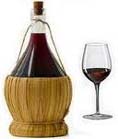Italian Pantry Ingredients
from Italian Traditional Food
Essential Italian Pantry Ingredients
from Italian Traditional Food
Here is a selection of Italian pantry ingredients from Italian Traditional Food. These Italian pantry ingredients are
typically found in any well-stocked Italian kitchen. By stocking your kitchen with a few basic Italian pantry ingredients, you will be well prepared for making most Italian recipes. Just add a
few fresh ingredients and you'll be able to easily prepare most Italian dishes. Also checkout the Articles, Articles 2, Articles 3,
Articles 4, Articles 5, Articles 6, Articles 7, Glossary, Glossary 2, Glossary 3, Glossary A-E, Glossary F-N, Glossary O-Z, FAQ,
FAQ 2, FAQ 3,
Measurement Converter, Oven Temperatures, Cooking Tips,
Cookbooks, Cookbooks 2, Cookbooks 3 and Recipes pages.
Italian Pantry
Ingredients
ANCHOVIES: Anchovies are a small, shiny,
silver fish native to the Mediterranean and thus very popular in the local cuisine. Many Mediterranean recipes use
anchovies for additional flavour.
BALSAMIC VINEGAR: The rich, slightly sweet
flavour of balsamic vinegar readily lends itself to vinaigrette dressings, gourmet sauces, and brings out the
sweetness of fresh fruits such as raspberries, strawberries, and peaches. Balsamic vinegar is made from grape
pressings that have never been permitted to ferment into wine. Some balsamic vinegars have been aged for over 100
years. It is this aging process that makes true balsamic vinegar from Modena in Northern Italy so expensive.
CAPERS: Capers are the unripened flower buds
of a prickly, perennial plant (Capparis spinosa) which is native to the Mediterranean and some parts of Asia. After
the buds are harvested, they are dried in the sun, then pickled in vinegar, brine, wine or salt. Capers lend a
piquant, sour, and salty flavour to salads, dressings, sauces, vegetables and a variety of main dishes.
CHEESES: Cheese is a very important ingredient
for Italian dishes. The most common varieties used include Parmigiano Reggiano, pecorino Romano, mozzarella,
ricotta and provolone.
CORNMEAL: Cornmeal is flour ground from dried
maize. It is a common staple food, and is ground to fine, medium, and coarse consistencies. Use a medium textured
cornmeal for polenta.
DRIED PASTA: Dried pasta can only be made from
durum wheat flour. Durum flour has a yellow tinge in colour. Use dried pasta imported from Italy from such
manufacturers as Barilla and De Cecco. Italian pasta is traditionally cooked "al dente", that is firm to the
bite.
DRIED PORCINI MUSHROOMS: They add a wonderful
rich flavour to risottos, pasta sauces, and stews.
FLOUR: Keep both plain (all-purpose) and
self-raising flour.
GARLIC: Always useful to have in your pantry
as it is used in quite a few Italian recipes.
HERBS: Ideally fresh herbs should be used in
Italian cooking, but it is also acceptable to use dried herbs such as, oregano, rosemary, thyme, and sage.
LEGUMES: These can be dried cannellini beans,
borlotti beans, chick peas (ceci) and lentils. They are very useful additions to soups.
OLIVE OIL: This is an essential ingredient of
Italian cooking. Using extra virgin olive oil will add flavour to most dishes.
OLIVES: Try to keep both the black and green
varieties.
ONIONS: Use white onions for cooking and red
onions for salads.
PARMIGIANO REGGIANO: This cheese is produced
in the Parma region of Northern Italy. It's a cheese full of flavour, texture, and richness that make it both an
excellent grating cheese and one of the world's great table cheeses.
RICE: Always have some Arborio rice in your
pantry as it is vital in the making of risotto.
SEASONINGS: Black peppercorns, sea salt and
red pepper flakes are important seasonings in Italian cooking.
TOMATOES: Try to use fresh tomatoes but good
quality canned tomatoes are also acceptable. Use Italian San Marzano tomatoes as they are the best.
Locate another Italian Traditional Food web site page here
Trust that you found the above Italian pantry ingredients information useful.
| 

 Digg
Digg Stumbleupon
Stumbleupon Google Bookmarks
Google Bookmarks Delicious
Delicious Twitter
Twitter Facebook
Facebook Yahoo My Web
Yahoo My Web Reddit
Reddit